Hundreds of North Shore residents were among the estimated three million protesters who participated in women’s marches across the globe on Saturday.
“I realized the only way I’ll be comfortable is if I stand up,” said Stephanie Hall, a Port Washington resident who drove to the march in Washington, D.C., with her mother and niece.
“A lot of us voted but unfortunately those votes aren’t visible,” she added. “By going to Washington you could see all those bodies. It’s a visual reminder that this is what we believe in. Listen to us; we’re here.”
Protesters from the North Shore cited women’s rights, racial and economic justice and opposition to the agenda of President Trump as issues that prompted them to join the marches.
Hall said a group of Port Washington women organized buses to the march through a private Facebook group.
The women wore “blue and white knit caps that said ‘you are the change’ on the front,” she said.
Among the Manhasset attendees at the march in Washington was Regina Rule, president of the Board of Education.
A bus of 53 women traveled from the Unitarian Universalist Congregation at Shelter Rock, in Manhasset, early Saturday morning.
Lisa Simon, the chair of the congregation’s social justice committee, said the bus included members of the church in Manhasset as well as members from churches in Huntington, Garden City and Freeport. Some people unaffiliated with Unitarian Universalism were also on board.
“It was a full, full day of traveling and marching,” Simon said.
She recalled walking down Independence Avenue with the Capitol directly in front of her.
“The police officers were very friendly,” she said. “They said, ‘keep moving, there’s a million more people behind you.’
“On Independence Avenue there are residential homes all the way down,” she added. “In front of the homes there were black and white signs with different quotes from Martin Luther King Jr. It was very powerful to read them as we were walking down.”
Hall said the march “was a little confusing because there were so many people that there wasn’t anywhere to march.”
“It became many marches. Two thousand of us were marching toward the Washington monument but going in the wrong direction,” she said. “It was still pretty cool.”
Ned Wight, the senior minister at the Unitarian Universalist Congregation at Shelter Rock, marched at a sister event in Manhattan.
“People wanted to ensure that women and gay and lesbian and bisexual people, and persons of color and disabled people—groups traditionally marginalized—are on the radar screen of all elected leaders,” he said. “The caliber of a nation and a society is judged by how they treat all of their people.”
“The crowd was so dense that it took us three hours to go a half a block,” he added. “What was amazing about it was that given how constraining it was and how many people were packed in, they were still relatively patient and forbearing about being in such close and crushed quarters.”
“There was a good spirit in the air.”
Marches were held in Sydney, Berlin, London, Paris, Nairobi and Cape Town as well as at least 500 U.S. cities, according to data collected by Erica Chenoweth at the University of Denver and Jeremy Pressman at the University of Connecticut.
Simon said protesters “felt very uplifted and empowered” on the bus ride home, which arrived at the congregation at 12:15 a.m.
“The question was: what can we do now?” she said.
Simon, Hall and Wight said they intend to remain involved in advocacy activities like the women’s march.
“I don’t see myself giving up,” Hall said. “We have to remain vigilant.”
Simon said she intends to participate in an April 15 march that will call on President Trump to release his tax returns. She has also been calling her elected representatives.
“We need to keep our eyes open and have our voices heard,” Simon said.



